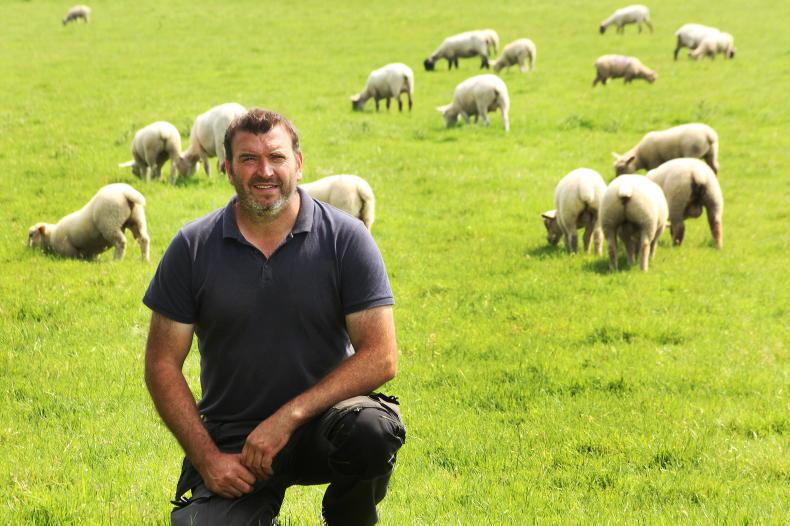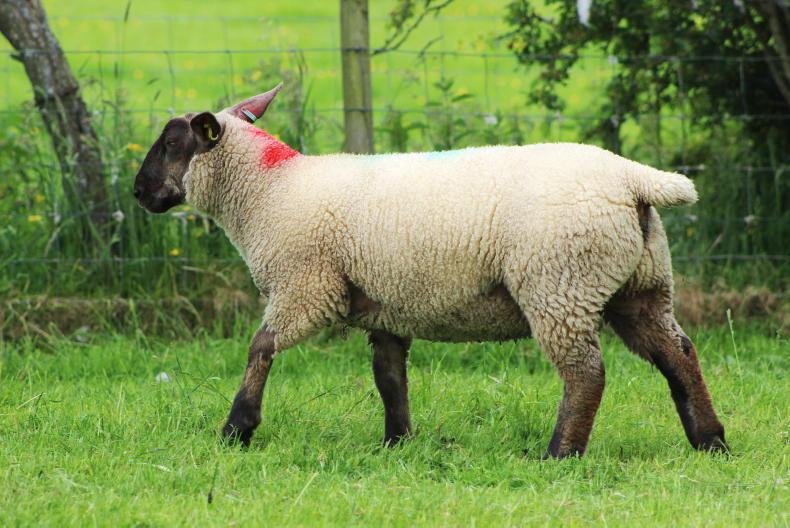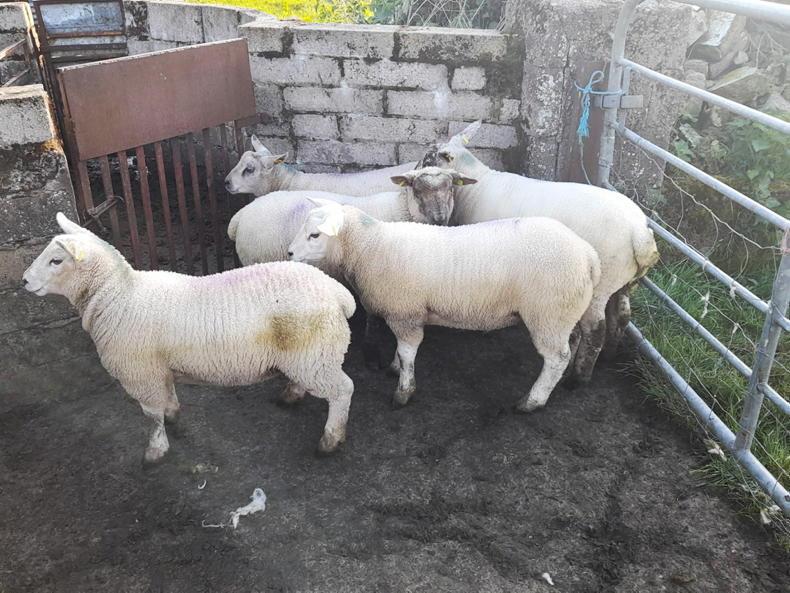Mark Davidson operates a lowland sheep unit outside Dungannon, Co Tyrone, with mature ewes lambing in two batches during February and March.
Lamb performance has been excellent in recent weeks, coinciding with the upturn in grass growth. The first group of lambs was drafted for slaughter on 23 May with six ram lambs offloaded.
This week sees the drafting of lambs getting into bigger numbers with 26 animals sold for direct slaughter.
Again, the majority of this group is made up of ram lambs with a few females that do not fit in with Mark’s replacement policy.
So far, most of the lambs slaughtered are out of Suffolk ewes and sired by a Texel ram.
Lambs are killing out at 50% of final liveweight with animals being drafted between 40kg and 45kg liveweight.
All lambs slaughtered to date are being finished off grass and conformation is ticking the boxes for market specification.
All lambs are U grading with the majority at fat class 3, although there was an occasional fat class 2.
Drafting rate
Grass growth has been excellent on the farm over the past month and Mark has seen a big change in lamb performance.
He still plans to draft every fortnight, as the availability of grass means he is not under pressure to shift lambs once they hit the 40kg to 45kg liveweight range.
Drafting every two weeks, instead of weekly sorting, is helping to get more lambs into fat class 3, improving the overall carcase value of animals at slaughter.

Mark Davidson on his farm at Dungannon, Co Tyrone. \ Houston Green
However, if grass growth does start to slow down, then Mark is planning to move to a weekly draft of lambs. This will ease grazing demand, leaving more grass for later-born lambs.
Selecting replacements
As well as selecting lambs for slaughter, Mark has been busy pulling out ewe lambs for future flock replacements.
To be selected as a replacement, ewe lambs must be a twin born animal, born without assistance and reach the drafting weight as quickly as possible.

Ewe lambs are also being selected as flock replacements.
Fast-growing lambs on a grass system will reflect the best genetics in the flock, along with ewes that possess strong milking ability. Other factors include the physical elements such as feet, legs, mouth, etc, as well as a tight fleece.
In total, 70 ewe lambs will be kept as replacements with the aim of having 60 to 65 animals lambing down next spring.
Dry ewes
Once lambs are drafted, ewes are removed from the grazing group and put on bare pasture in smaller paddocks beside the main yard.
This gives Mark greater control over grass intakes, as well as being able to keep a close eye on animals during the transition into the dry period.
Weather delays first-cut silage harvesting
First-cut silage will be finished up this week with 24 acres of grass going in the pit. This is later than planned, but is something that was outside of Mark’s control.
Weather conditions have been extremely changeable in the northern half of the country, making it difficult to get a suitable window for mowing, wilting and harvesting grass.
The contractors have also been backlogged due to wet weather, meaning farmers with smaller silage areas to cut have faced delays.
Once harvested, the same 24 acres will be closed up again for second-cut silage after ground gets slurry and fertiliser.
Surplus grass
Mark did make the most of the handful of dry days this month and has taken out surplus grass on the grazing block.
So far, 90 bales have been saved from 16 acres of grazing and as aftermaths rejoin the rotation, this will provide high-quality grass to boost lamb performance.
These bales can also be kept separate and targeted to specific animal groups this winter to maintain performance.
Fertiliser
There is 4.5t of fertiliser on farm to cover second cut and grazing over the summer, although grazing and silage applications will depend on growth rates in the coming weeks.
No fertiliser has been applied since early May and coming in to the summer, the plan is to dress grazing swards with a little and often approach of 0.5 bags/acre as needed.
Keeping on top
of flock health
All mid- and late-season lambs have now been treated for fly control as the flock enters the period of high risk from blowfly.
A combination of products have been used but in all cases, a pour-on has been the preferred choice for prevention.
Lambs in the early lambing group were not treated as Mark finds these animals are normally coming fit for slaughter once the risk of blowfly increases.
Clipping
All being well, ewes will be clipped around 20 June, similar to other years. Ewes have been dagged as necessary and Mark is keeping a close eye on these animals for any sign of flystrike.
This course of management has meant that Mark has not needed to dip ewes in recent years, which is a major plus for a variety of reasons.

Lambs are being drafted for slaughter every fortnight.
69ha lowland grassland unit.250 breeding ewes and 60 ewe lambs.Suffolk, Texel and Belclare cross ewes.35 spring-calving cows.
Mark Davidson operates a lowland sheep unit outside Dungannon, Co Tyrone, with mature ewes lambing in two batches during February and March.
Lamb performance has been excellent in recent weeks, coinciding with the upturn in grass growth. The first group of lambs was drafted for slaughter on 23 May with six ram lambs offloaded.
This week sees the drafting of lambs getting into bigger numbers with 26 animals sold for direct slaughter.
Again, the majority of this group is made up of ram lambs with a few females that do not fit in with Mark’s replacement policy.
So far, most of the lambs slaughtered are out of Suffolk ewes and sired by a Texel ram.
Lambs are killing out at 50% of final liveweight with animals being drafted between 40kg and 45kg liveweight.
All lambs slaughtered to date are being finished off grass and conformation is ticking the boxes for market specification.
All lambs are U grading with the majority at fat class 3, although there was an occasional fat class 2.
Drafting rate
Grass growth has been excellent on the farm over the past month and Mark has seen a big change in lamb performance.
He still plans to draft every fortnight, as the availability of grass means he is not under pressure to shift lambs once they hit the 40kg to 45kg liveweight range.
Drafting every two weeks, instead of weekly sorting, is helping to get more lambs into fat class 3, improving the overall carcase value of animals at slaughter.

Mark Davidson on his farm at Dungannon, Co Tyrone. \ Houston Green
However, if grass growth does start to slow down, then Mark is planning to move to a weekly draft of lambs. This will ease grazing demand, leaving more grass for later-born lambs.
Selecting replacements
As well as selecting lambs for slaughter, Mark has been busy pulling out ewe lambs for future flock replacements.
To be selected as a replacement, ewe lambs must be a twin born animal, born without assistance and reach the drafting weight as quickly as possible.

Ewe lambs are also being selected as flock replacements.
Fast-growing lambs on a grass system will reflect the best genetics in the flock, along with ewes that possess strong milking ability. Other factors include the physical elements such as feet, legs, mouth, etc, as well as a tight fleece.
In total, 70 ewe lambs will be kept as replacements with the aim of having 60 to 65 animals lambing down next spring.
Dry ewes
Once lambs are drafted, ewes are removed from the grazing group and put on bare pasture in smaller paddocks beside the main yard.
This gives Mark greater control over grass intakes, as well as being able to keep a close eye on animals during the transition into the dry period.
Weather delays first-cut silage harvesting
First-cut silage will be finished up this week with 24 acres of grass going in the pit. This is later than planned, but is something that was outside of Mark’s control.
Weather conditions have been extremely changeable in the northern half of the country, making it difficult to get a suitable window for mowing, wilting and harvesting grass.
The contractors have also been backlogged due to wet weather, meaning farmers with smaller silage areas to cut have faced delays.
Once harvested, the same 24 acres will be closed up again for second-cut silage after ground gets slurry and fertiliser.
Surplus grass
Mark did make the most of the handful of dry days this month and has taken out surplus grass on the grazing block.
So far, 90 bales have been saved from 16 acres of grazing and as aftermaths rejoin the rotation, this will provide high-quality grass to boost lamb performance.
These bales can also be kept separate and targeted to specific animal groups this winter to maintain performance.
Fertiliser
There is 4.5t of fertiliser on farm to cover second cut and grazing over the summer, although grazing and silage applications will depend on growth rates in the coming weeks.
No fertiliser has been applied since early May and coming in to the summer, the plan is to dress grazing swards with a little and often approach of 0.5 bags/acre as needed.
Keeping on top
of flock health
All mid- and late-season lambs have now been treated for fly control as the flock enters the period of high risk from blowfly.
A combination of products have been used but in all cases, a pour-on has been the preferred choice for prevention.
Lambs in the early lambing group were not treated as Mark finds these animals are normally coming fit for slaughter once the risk of blowfly increases.
Clipping
All being well, ewes will be clipped around 20 June, similar to other years. Ewes have been dagged as necessary and Mark is keeping a close eye on these animals for any sign of flystrike.
This course of management has meant that Mark has not needed to dip ewes in recent years, which is a major plus for a variety of reasons.

Lambs are being drafted for slaughter every fortnight.
69ha lowland grassland unit.250 breeding ewes and 60 ewe lambs.Suffolk, Texel and Belclare cross ewes.35 spring-calving cows. 








 This is a subscriber-only article
This is a subscriber-only article










SHARING OPTIONS: